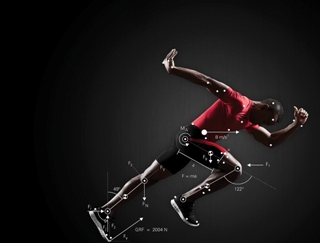May 30 2015
OptiTrack today announced a substantial expansion of its biomechanics toolset, designed to simplify the capture and analysis of motion data for gait analysis, sports performance, and other biomechanics applications.
 OptiTrack offers a blend of performance and usability that produces high-precision, biomechanically-relevant motion capture data via workflows that are unprecedented in their simplicity. (Graphic: Business Wire)
OptiTrack offers a blend of performance and usability that produces high-precision, biomechanically-relevant motion capture data via workflows that are unprecedented in their simplicity. (Graphic: Business Wire)
In addition to native support for force plates, EMGs, and analog signal acquisition, OptiTrack’s Motive software now also features deeper integration with C-Motion’s Visual3D modeling and analysis package, as well as new biomechanically relevant marker sets ready to export into MATLAB, LabVIEW, or any third party biomechanics analysis application. This new workflow, including real-time motion capture and force plate data, will be on display in the OptiTrack booth #101 at the American College of Sports Medicine’s 62nd Annual Meeting in San Diego, California held May 26-30, 2015.
“OptiTrack has transformed motion capture with its uncommonly simple workflows, industry leading 3D accuracy, and most of all by making it accessible to just about any budget. With highly capable systems starting at $7K, and new options for fully-integrated movement analysis systems, we’re providing the access to optical tracking that hospitals, gait labs, rehab centers and universities of any size have been waiting for,” said Jeff Beavers, Director of Life Sciences at OptiTrack. “Ultimately, our technology’s accessibility means that more biomechanists will be performing more research, thus expanding the knowledge of the biomechanics community at a faster pace.”
Kait Jackson, Head of Sports Science at The Performance Lab in Toronto, is using OptiTrack with Visual3D for real-time biomechanical analysis and biofeedback of elite athletes. She shared, “Data quality is fundamental to accurate analysis, and OptiTrack’s 3D precision competes with the best in motion capture. By enabling simple, customizable integration with Visual3D, I’m able to build an accurate model that I need for my assessments, and then feed it exceptionally high-fidelity motion data–both of which are crucial for reliable analysis.”
Key features of Motive include:
- Seamless integration with Visual3D (V3D) – Motive’s biomechanics marker sets provide a simple pathway between labeling and analysis by leveraging file structures that are compatible with Visual3D; tracking data, subject variables, device specs, force vector data and analog device data can be combined into a single, enhanced C3D file. Additionally, Motive users can stream live, labeled 3D marker data to V3D via free plugin to the V3D Real-time Server, which is ideal for real-time analysis, biofeedback, and verification.
- Native support for AMTI force plates – Motive’s plug and play force plate support includes all digital AMTI force plates and amplifiers. Native support includes simple, one-click positioning in the tracking volume as well as real-time display, capture and export of force vectors.
- DAQ support for EMGs, force plates and accelerometers – Motive’s native support for any USB National Instruments DAQ enables perfectly synchronized motion and analog data. This allows for acquisition from any general analog device, including force transducers, EMGs, EEG, EKG, force places, accelerometers, and more.
- Validated biomechanics marker sets – Motive:Body comes equipped with a variety of commonly-used pre-built biomechanics marker sets, including variations of the conventional gait model (e.g. Helen Hayes), Anatomical Sets and 6DOF sets. These options include some of the most biomechanically-accurate marker sets, which have previously been difficult to capture with smaller camera counts. Wherever analysis takes place, these marker sets provide ready access to common tools and can be augmented with additional markers for capturing more custom datasets.
- Kinematic labeling – Motive’s real-time labeling engine leverages a clear understanding of a subject’s unique skeletal structure to deliver highly accurate labels, even during occlusive interactions between limbs or other objects. When additional labeling is needed, industry-standard naming conventions facilitate a simple, familiar labeling workflow.
- Data management tools – Easily manage complex capture sessions by creating a spreadsheet of trials and dragging them into Motive, or build the list directly in Motive’s project interface. Once a trial list has been created, Motive will automatically progress between recordings, with options for revising lists and trials on the fly. Quickly and automatically process and export large groups of trials via customizable scripts using the Motive Batch Processor.
- Open architecture – OptiTrack fits seamlessly into a range of existing workflows, offering access to camera images, centroids, reconstructed 3D points, skeletal data, and nearly everything in between via free developer SDKs.